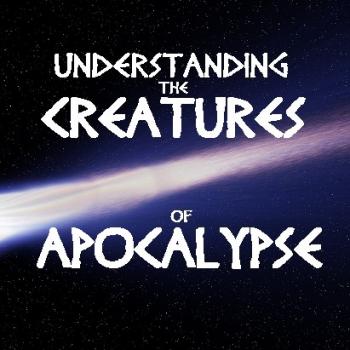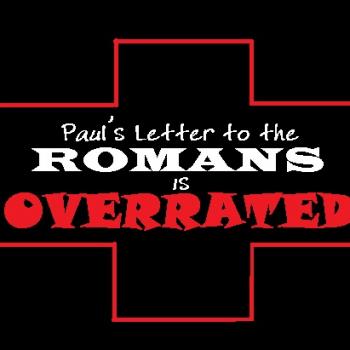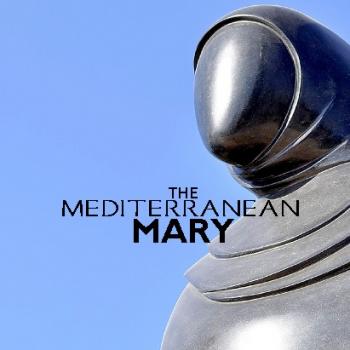
Revelation is a confusing book made even more so by Western cultural baggage and expectations.
Considering that November in Catholic thought reminds us the Last Things, I thought it might be appropriate to post something on the Bible’s last book: Revelation. This post will not come anywhere near to exhaustively covering the wonderful, ancient, and sacred document. I would just like to explore briefly three concepts featured within the book—cities, visions, and the sky. In doing that, we might see the need for a respectful reading of it.
Revelation & Ancient Cities
There seems to exist endless commentaries on the book of Revelation. Almost all share in the same groundless presupposition. They presume that 21st century readers comprehend what an ancient Mediterranean city meant to long dead city-dwellers. This is likely why almost none of these scholarly treatments bothers to define the ancient Mediterranean city. Is it the presumption that these ancient urban centers were identical to modern cities except lacking technology? Why else the dearth of necessary information, without which understanding is impossible?
What did the ancient polis mean in antiquity for residents and those impacted by them? To even begin to answer that question, wouldn’t I first need to grasp the prevailing social system? And where would I get hold of such knowledge?
It doesn’t matter if we are speaking about a 21st century Euro-American city, or a pre-Industrial Medieval civitas, or an ancient Mediterranean polis. The prevailing social systems give those urban centers their specific meanings. The particular urban center expresses those social meanings.
I bring this up because ancient Mediterranean cities feature prominently in the document called Revelation. Seven Greco-Roman cities hosted first century Jesus groups, whose prophets were the intended recipients of its letter. The earthly temple-city Jerusalem is featured among its visions. The mother of all cities, Babylon, is also. The book ends with the descent of a sky city bearing astronomic proportions, New Jerusalem.
Revelation and Rome
One city not featured with any prominence or importance in Revelation is Rome. Contrary to immense popular opinion, the great villain of the last book of our New Testament library is not Rome, but deception. That Revelation is about Rome is a favored yet tenuous hypothesis for biblical scholarship. There is no proof to it, only gratuitous insistence.
Rome doesn’t figure into the author’s concerns, according to Bruce Malina and John Pilch in their groundbreaking Social-science Commentary on the Book of Revelation. Neither Rome the empire nor Roman emperors (e.g., Nero) are referenced by Revelation in ways clear, unambiguous, or direct.
The Visions of Revelation
Contemporary cognitive neuroscience explains that the average human person changes levels of consciousness many times daily. According to Vincent Crapanzano, human beings are capable of experiencing over 35 different levels of awareness. Further, John Pilch informs us that ethnographic evidence indicates that perhaps as many as 90 percent of the present population on earth experience many of these on a routine basis. Altered states of consciousness is the technical term for this panhuman experience.
From Genesis to Revelation, the Bible records many ASC experiences. From the “heavy, [God-induced] sleep” of Adam (Genesis 2:21; compare Isaiah 29:10; 1 Samuel 26:12) all the way to the book of Revelation, we see trance experiences recorded (Revelation 1:10; 4:2; 17:3; 21:10, where “in spirit” means “in trance”).
Pilch affirms that alternate states of consciousness are “a select moment during which God reveals Godself and important information for human beings” (see Genesis 15:12; 1 Samuel 3:1-18; Job 4:13).
The Sky and its Denizens
We all should strive to be considerate readers of any document. This would be especially true of our revered Scriptures! So what would be the first task in considerately reading the Bible? How can it be anything other than discovering and understanding what the human author actually wrote and intended to communicate?
There exists an abyss of millennia and immense cultural differences that separate us from biblical writers like John of Patmos. The Mediterranean culture of the Bible, so alien to our Western society, shaped these people. They lived and breathed it. Therefore, whenever a 21st century Western person reads and thinks abut “Revelation,” he or she better check his conceptual “reading glasses.”
John Pilch was fond of saying, you can’t know what the Bible means until you realize what the Bible meant. How do we discover what Revelation originally meant? From WHERE do we derive that first, original meaning of “Revelation”? The meaning of any written document is always rooted in and derived from the social system of the author. Therefore, in order to understand the literal meaning of a biblical author, one must learn the social system of that author. That means learning it from that ancient author’s time, place, and culture. That’s not so easy, folks!
So we must ask: What is the first-century, literal meaning of the book of Revelation? For this, we must step into the author’s first century Mediterranean world. That world was at the center of the universe, as our first-century author—or authors (because “Revelation” was compiled by more than one writer!)—understood it!
Revelation and Cosmology
In a previous post we spoke about different Biblical cosmologies. Like us, our ancient Mediterranean ancestors witnessed stars and planets, sun and moon, moving across the sky in well-known patterns. But unlike us, they thought of the sky as a series of metallic or crystal vaults encapsulating the stationary earth. Besides that, they conceived of these sky entities as other-than-human persons (i.e., spirits).
Ever pray to Saint Michael the Archangel? Well, first century Jesus groups looked up and saw the constellation called elsewhere Orion, and thought that was him! Different Mediterranean peoples had different takes on common Mediterranean sky lore.
These lesser gods and stellar beings were seen as powerful sky-servants of the Most High God. They directly affected the affairs of humankind below. They could be called upon for protection—or for an act of mercy. These personified stars and planets also could do great harm to the peoples and kingdoms under their power. It was necessary for biblical people to know a prophet who could read the stars’ intentions and could control their capricious influences.
Following the Context Group scholars, we have abundant astrological information from biblical times. These records inform us about how first century Mediterraneans understood the earth. Sorry flat-earthers, but our first century ancestors in faith conceived of a round earth, although fixed and motionless, smackdab at the center of creation. They imagined it encapsulated within the vault of the sky.
On the interior of these sky vaults, stars, singular or in constellated form, moved in regular pathways. One astral pathway fell above the earth’s equator, the celestial equator, where sky vault bowls connected. The other was the ecliptic, the pathway of the sun. Twelve constellated patterns along this astral path formed the zodiac, twelve star-patterns that get dressed by the Sun one month each year.
Not an Apocalypse, but Sky Lore
About a century ago, a number of scholars gave a fascinating explanation for the type of writing, imagery, and vocabulary of the visions in the book of Revelation. They agreed that they were typical of ancient astronomy and astrology, seen back then as identical. Scholars Franz Cumont, Franz Boll, Wilhelm Gundel, and André Festugière suggested that the astronomic report is the closest literary genre that fits what the book of Revelation us. Apocalypse is not apocalyptic, folks.
According to Bruce Malina, these studies indicate that John the Seer—primary human author behind Revelation—needs to be taken at his word. Does John claim that he went up into the sky vault and looked around? If so, he obviously must have believed that he had actually gone up there and looked around! Malina held it was preposterous to imagine John fabricating fiction, symbolic narratives, or composing a midrash. He wasn’t allegorizing either. John the visionary saw whatever he said he saw, and not allegories to other things.
Sadly, almost every popular commentator reads Revelation allegorically for theological relevance for today’s Christians. Some scholars attempt an “historical” approach, explaining John’s message to his anxious churches, groups oppressed and persecuted by Rome. Some non-scholarly (i.e., fundamentalist) commentaries are “futurist,” claiming absurdly that John’s visions are immediately relevant for twenty-first century people.
But this is all poppycock and gobbledygook. Revelation describes the sky! It details the author’s visions of events taking place in the sky as imagined and understood by a first century Israelite astral prophet. The best place to teach the Book of Revelation would be in a Planetarium, not a church.
For Whom Did John Write?
The letter of Revelation was not addressed to Americans or Russians, certainly. But it was not even written for all believers in those seven Jesus groups in Asia Minor, either! This Hellenistic letter was sent specifically to John’s fellow Jesus-group prophets (Revelation 1:9; 19:10; 22:9).
Now let’s see if the American Christians reading this can swallow that. Revelation was not being authored or sent to “the average Jesus-believer” in Asia Minor. Bruce Malina explains that the democratization of the New Testament writings happened far later in history, indeed, as late as the Reformation!
The first believers were not Americans! They lacked American expectations. Malina informs us that ancient documents containing revelations from God (or the gods) were never meant for just anybody. The visions of John were meant for his fellow Jesus group prophets. In turn, presumably, these astral prophets would impart their meaning to their Jesus-groups, albeit with a considerate explanation.
Ending the Book about the End
The conclusion of Revelation leaves many European and North American Bible readers unsatisfied. Shouldn’t it conclude logically and neatly, like our Western stories do? Shouldn’t it follow a logical progression until finally reaching the endpoint? Bruce Malina notes that the word “logical” is to be found all over commentaries on the final chapters of the book. It’s only natural, and telling, as “logical” features prominently in their 20th and 21st century Western expectations.
But Malina and Pilch explain to us that ancient sky lore is not logical or keyed to 21st century Western expectations. Did ancient observers of the Mediterranean sky have any interest in Western logic? They saw a piece of the sky and they jotted down what they saw.
Perceiving that Revelation lacks a proper Western story-ending (meaning a logical conclusion) didn’t emerge until the Romantic period. We can blame Romanticism for biblical scholars starting to read the Bible as a story, a Geschichte. Malina explains that the “roman” part of the word romantic originates from the French and German term for the “novel.” It was the novel genre that popularized perceiving human social reality as founded in story. It is a human story where chronology, time sequence, emotional development, and uniqueness count. So the Bible became a novel.
Not a Novel
This was read back into Irenaeus (d. 202) as Salvation History. Crude forms of this proliferate with Jeff Cavins and Scott Hahn Bible “studies.” Since their agenda is Catholic triumphalism, the End of the Novel called “Salvation History” becomes the Mass and the final Kingdom of God equals the Catholic Church. Ecumenism and interreligious dialogue are crippled. We win! We’re the best! Yay!
Read romantically as a novel, the book of Revelation becomes the bookend mirror-piece to Genesis. Eschatology needs protology! If Revelation was to describe the End, it must itself have a satisfactory and logical conclusion to the Beginning, no? The Bible is the Greatest Novel ever read! It’s unfolding story can’t finish with a dud, or something bizarre to modern humans. The birth of the Germanism “salvation history” came out of this desire to ethnocentrically and anachronistically read the Bible as a Western novel. From Creation to Cosmic Conclusion, it’s all about us.
Malina and Pilch invite readers to discover what Revelation the document meant to its original audience. Do that and you will see that logical novel format and story wasn’t the goal in writing it. One purpose of it was describing relevant segments of the sky vault.
The main purpose of composing and compiling Revelation was communicating Israelite astral prophecy. Specifically, it describes what was going on in segments of the sky vault of significance to John’s audience in ancient cities. It was to assure them of what must take place soon (Revelation 1:1). But as they wait for what is immanent, a warning was given—watch out for deception. “Don’t be deceived!” is the perpetual warning in Revelation. The author cares nothing about Imperial Rome.
Western Garbage Reading
So much of our current biblical interpretation springs from the imagination of historians fancying scenarios of unverifiable possibilities they have retrojected onto antiquity. Even brilliant scholars have cultural baggage that acts as a filter blinding us to what was in favor of how we Western readers are.
Altered states of consciousness experiences can be found among 90 percent of the planet’s populations today. This is a plausible model for what John’s astral visions really were. It fits well with many alive today in the Mediterranean of 2019. But not so much among Westerners who block them. This panhuman dimension got filtered out as irrational by the Enlightenment. So by and large, Biblical scholars don’t even consider ASCs.
A sound historical approach informed by the social sciences to Revelation (and to the entire Bible) helps us escape anachronistic and ethnocentric readings. We gain increased comprehension of the people who wrote it and also those who are described within New Testament documents. Biblical scenes delineate the behavior ascribed to God via analogy to culturally specific human behavior.
Conclusion: A Culturally-Informed Reading
Approaching Revelation (and the whole Bible) this way, knowing and appreciating persons who embody biblical faith emerges as biblical dogmas vanish. As we discover in it social persons and the roots of their interpersonal propositions, moral directives and theological propositions leave us.
Reading it this way, respectfully, the Bible begins to be seen reflecting a “religion of persons” rather than the “religion of the book.” We see at the very source of our Christian tradition theocentric and Christocentric successes and failures.
Reading it this way, respectfully, we become acquainted with our biblical ancestors in faith rather than abstract theology. We actually come to understand their quest for meaningful human existence.












